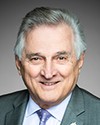Thank you very much, sir.
Thank you for inviting us here today to discuss a subject that is a priority for the Canadian Armed Forces. As indicated, I am Lieutenant-General Chuck Lamarre. I'm chief of military personnel, and I am champion for visible minorities in the Canadian Armed Forces.
Diversity is of primary importance because the Canadian Armed Forces must reflect the society they serve. In turn, we benefit from a variety of perspectives at home and on operations. At the core, actively seeking diversity in the forces brings us the talent critical in maintaining the defence of Canada and Canadians.
We're undertaking to achieve this diversity through the combination of sound policy, focused attraction, recruiting and retention as well as culture change.
First, I'd like to introduce those who are here with me today. They too will provide short opening statements, share their perspectives on diversity and answer your questions.
To my right is Lieutenant-General Jean-Marc Lanthier, commander of the Canadian Army and champion for indigenous peoples. Rear-Admiral Luc Cassivi is to his right, commander of the Canadian Defence Academy responsible for professional military education in the Canadian Armed Forces, and co-champion for gender and diversity in operations. To his right is Commodore Rebecca Patterson, director general of the combined sexual response team and champion for women.
To begin, I will provide an update on the Canadian Armed Forces diversity strategy and action plan. In early 2017, the chief of the defence staff signed the Canadian Armed Forces diversity strategy. As a result of the release of “Strong, Secure, Engaged” later that same year, the diversity strategy is now undergoing a comprehensive review with extensive stakeholder engagement. A revised diversity strategy will be issued in 2019 as a long-term plan for the future to diversify our forces in line with our defence policy, “Strong, Secure, Engaged”.
As the champion for visible minorities, my responsibilities include engaging in and supporting the programs and initiatives that encourage the presence and contributions of visible minorities within the Canadian Armed Forces. In collaboration with our defence advisory groups, which act as intermediaries between the members of visible minority groups and organizational leadership, we've implemented a number of positive changes to be inclusive of a diverse workforce.
For example, the dress manual policy now includes clauses related to religious accommodations for members' hair. Muslim women may wear the hijab in a modified uniform. Jewish members may wear the yarmulke with numerous orders of dress. During some of our events, aboriginal and Métis members proudly wear the aboriginal veterans medallion or the Métis sash. Sikh members may observe the five symbolic aspects of the religion and wear a turban, subject, of course, to safety and operational considerations.
In addition, the policy has been amended to allow members to observe prayer and fasting requirements that align with religious practices. We also offer access to a variety of meals at home and during operations, including kosher and halal preparations for our field rations.
To ensure that we are truly welcoming towards all applicants, the forces continue to modernize, streamline and standardize recruiting. I would invite all of you to visit our new recruiting website at forces.ca, which was, of course, partially in response to the Auditor General's reports that talked about modernizing the recruiting system.
We have recruiters who are multilingual and from a wide range of ethnic and racial backgrounds. Combined with programs such as the aboriginal awareness and cross-cultural training, designed to sensitize all recruiters to cultural norms that may differ from their own background and beliefs, we have enabled easier communication with potential recruits and alleviated many of the misconceptions that minorities sometimes have regarding the military.
The Canadian Armed Forces' values contribute to positive change. One of those is within our chaplain service, as an example. A tolerance and respect for all faiths is a non-negotiable prerequisite to serve as a chaplain in the Canadian Armed Forces, and we employ chaplains, both men and women, who are drawn from all major religions.
We continue to pursue diversity through other means, such as citizenship ceremonies, where our senior officers and senior non-commissioned members address new members of the Canadian family and encourage them to consider us as potential employers.
I believe our efforts have borne fruit already.
The Canadian Armed Forces' goal for the representation of visible minorities is set at 11.8% and we are currently at 8.7%. 1 believe we may be higher but cannot truly know beyond doubt because we rely on self-identification. I know of many members who do not self-identify as belonging to any group within visible minorities.
These individuals don’t want to be known for being a minority. They want to be known for being part of the Canadian Armed Forces. As a senior leader within this institution, I'm proud of this sentiment.
As chief of military personnel, one of my primary responsibilities is to ensure that the Canadian Armed Forces are able to generate an effective and responsive fighting force ready to deliver on the direction given to us by the government. This force must represent the Canadians it serves and must avail itself of the great talent in every part of our population.
Our approach of sound policy development, focused attraction, recruiting and retention, as well as cultural change, will enable us to do this.
Thank you.
I will now turn to Lieutenant-General Lanthier for his opening statement.


